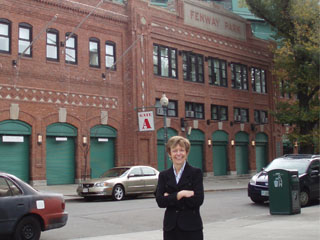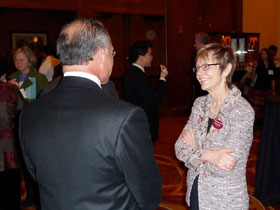 It was another great evening spent with new friends and many long-time supporters of the College. Our conversation in Boston covered much ground, including need-blind admissions and the admissions process more broadly, consensus--decision-making, the beauty of our physical campus, class size, interdisciplinary programs, and our ongoing work in and commitment to the City of Chester.
It was another great evening spent with new friends and many long-time supporters of the College. Our conversation in Boston covered much ground, including need-blind admissions and the admissions process more broadly, consensus--decision-making, the beauty of our physical campus, class size, interdisciplinary programs, and our ongoing work in and commitment to the City of Chester.
With respect to Chester, one of our alumni who worked there as an undergraduate wondered what current programs exist between the College and the city. Swarthmore continues the traditions of its founders in both the pursuit of academic excellence and the desire to apply what is learned in the classroom to improving the lives of others. We continue to be deeply engaged in Chester, through class work and honors seminars as well as through numerous initiatives coordinated or supported by the Lang Center. Our commitment to civic engagement also extends regionally to the city of Philadelphia and globally through summer research and efforts coordinated by the Lang Center, among others.
 Another alumnus asked how we are motivating faculty to undertake interdisciplinary work and to model it because this is clearly the future direction of higher education. Our support for and growth in interdisciplinary offerings has vastly expanded and enriched our curriculum in recent years. Approximately 35 percent of our students major in the interdisciplinary fields of engineering, psychology, and the sciences. Our faculty recently approved new guidelines for faculty appointments suggesting that the contribution to interdisciplinary studies be a factor in all new appointments. Although not a requirement, it will be a strong consideration.
Another alumnus asked how we are motivating faculty to undertake interdisciplinary work and to model it because this is clearly the future direction of higher education. Our support for and growth in interdisciplinary offerings has vastly expanded and enriched our curriculum in recent years. Approximately 35 percent of our students major in the interdisciplinary fields of engineering, psychology, and the sciences. Our faculty recently approved new guidelines for faculty appointments suggesting that the contribution to interdisciplinary studies be a factor in all new appointments. Although not a requirement, it will be a strong consideration.
The new guidelines also stipulate that faculty consider the possibility of Tri-College interdisciplinary partnerships in all requests for additions to academic departments. This holds great promise for the expansion of our Tri-Co collaboration with Haverford and Bryn Mawr, and there are opportunities to expand upon our relationship with Penn faculty, as well.
Finally, the size and nature of the intellectual community at Swarthmore is such that faculty and students often interact with one another across disciplines, in ways both formal and informal. You might find a poet talking to a physicist or a neuroscientist sharing research findings with a linguist. The inherent intellectual curiosity of our faculty and students guarantees that interdisciplinary work will not merely exist but will grow and thrive at the College.

Swarthmore can be proud of itself for being cutting edge in many areas, especially for a small college. I would encourage you to think deeply about the juxtaposition between Swarthmore's 'tradtional' role as a "prep school for grad school" and the diversity of the professions of its alumni. Is -academic- prestige really the most critical target?
I also worked in Chester for a bit and have been disappointed with the low number of African-Americans at Swarthmore. Because there is high competition for the best A-A minds in the nation's schools I have suggested the idea of dedicated scholarships attached to area high schools. Students who achieved to a certain level would be guaranteed admission and financial support. Alumni could be encouraged to help underwrite the bill. In addition, it would be an opportunity for the college to get more involved in "lower" education. Ideally, it might start a trend of area colleges "adopting" schools (even elementary and middle schools) and dedicating real attention to their success. Too often, the ivory tower is surrounded by institutions of k-12 education that don't meet basic standards. There is sexism and racism embedded in our favoring advanced education over the initial years. But a student who is well educated k-12 could fairly easily educate herself. Without that early education she is lost.
Please consider encouraging Swarthmore departments to explore how their expertise could pour back into the surrounding community.
Really happy you are at the helm.
Chris
Chris,
You are right that our alumni travel a wide variety of professional paths including medicine, law, business, non-profits, engineering, education, and the arts. While graduate work is one noble pursuit, so too are all the others and it's important that our current students understand that a Swarthmore degree can be applied to virtually any career choice.
The College remains committed to creating a richly diverse community of students. 38 percent of our current students are domestic students of color, with approximately 10 percent of those being African American. Even as we work to grow these numbers, we are also committed to making strides programmatically and within our surrounding communities. For example, two years ago the Chester Upland School of the Arts was "born," a unique public-private elementary school venture that has seen the intense involvement of both Professor of Music John Alston and Vice President Maurice Eldridge. Last year, the Delaware County College Access Center (DCCAC) opened, a shared venture with our other regional colleagues in higher education, and the first to serve as a resource to the at-risk population in Delaware County and in Chester. Just recently the DCCAC and the College joined other local partners in applying for, and receiving an $880,000 grant, "Project Blueprints" that engages at-risk minority youth from Chester with "opportunities for academic support, life skills training, personal development, cultural enrichment, and career exploration." Finally, our faculty and students are heavily invested in and committed to any number of projects and tutoring initiatives through their class work, as well as the Lang Center for Civic and Social Responsibility. So our commitment to the success of our primary and secondary school students runs deep at the College and is indeed "poured" back into the community, as you suggested.
We will continue to look for ways to make even further inroads and I welcome your suggestions as we do so.
Sincerely,
Rebecca Chopp